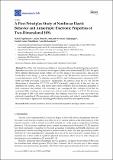A first-principles study of nonlinear elastic behavior and anisotropic electronic properties of two-dimensional HfS2
Author(s)
Faghihnasiri, Mahdi; Ahmadi, Aidin; Alvankar Golpayegan, Samaneh; Garosi Sharifabadi, Saeideh; Ramazani, Ali
Downloadnanomaterials-10-00446.pdf (3.979Mb)
Publisher with Creative Commons License
Publisher with Creative Commons License
Creative Commons Attribution
Terms of use
Metadata
Show full item recordAbstract
We utilize first principles calculations to investigate the mechanical properties and strain-dependent electronic band structure of the hexagonal phase of two dimensional (2D) HfS2. We apply three different deformation modes within −10% to 30% range of two uniaxial (D1, D2) and one biaxial (D3) strains along x, y, and x-y directions, respectively. The harmonic regions are identified in each deformation mode. The ultimate stress for D1, D2, and D3 deformations is obtained as 0.037, 0.038 and 0.044 (eV/Ang3), respectively. Additionally, the ultimate strain for D1, D2, and D3 deformation is obtained as 17.2, 17.51, and 21.17 (eV/Ang3), respectively. In the next step, we determine the second-, third-, and fourth-order elastic constants and the electronic properties of both unstrained and strained HfS2 monolayers are investigated. Our findings reveal that the unstrained HfS2 monolayer is a semiconductor with an indirect bandgap of 1.12 eV. We then tune the bandgap of HfS2 with strain engineering. Our findings reveal how to tune and control the electronic properties of HfS2 monolayer with strain engineering, and make it a potential candidate for a wide range of applications including photovoltaics, electronics and optoelectronics.©2020
Date issued
2020-03-01Department
Massachusetts Institute of Technology. Department of Mechanical EngineeringJournal
Nanomaterials
Publisher
Multidisciplinary Digital Publishing Institute
Citation
Faghihnasiri, Mahdi, et al., "A first-principles study of nonlinear elastic behavior and anisotropic electronic properties of two-dimensional HfS2." Nanomaterials 10, 3 (March 2020): no. 446 doi 10.3390/nano10030446 ©2020 Author(s)
Version: Final published version
ISSN
2079-4991